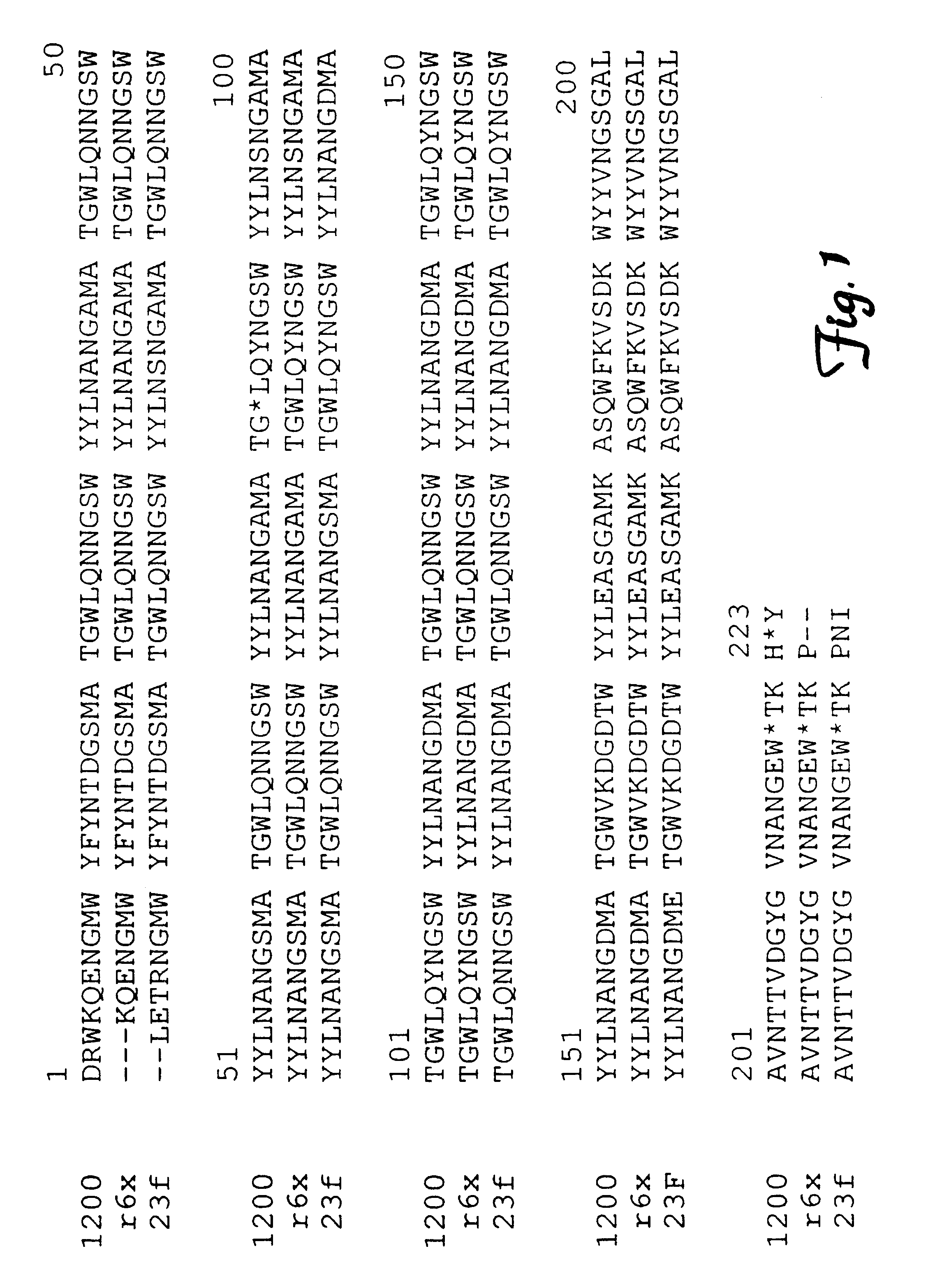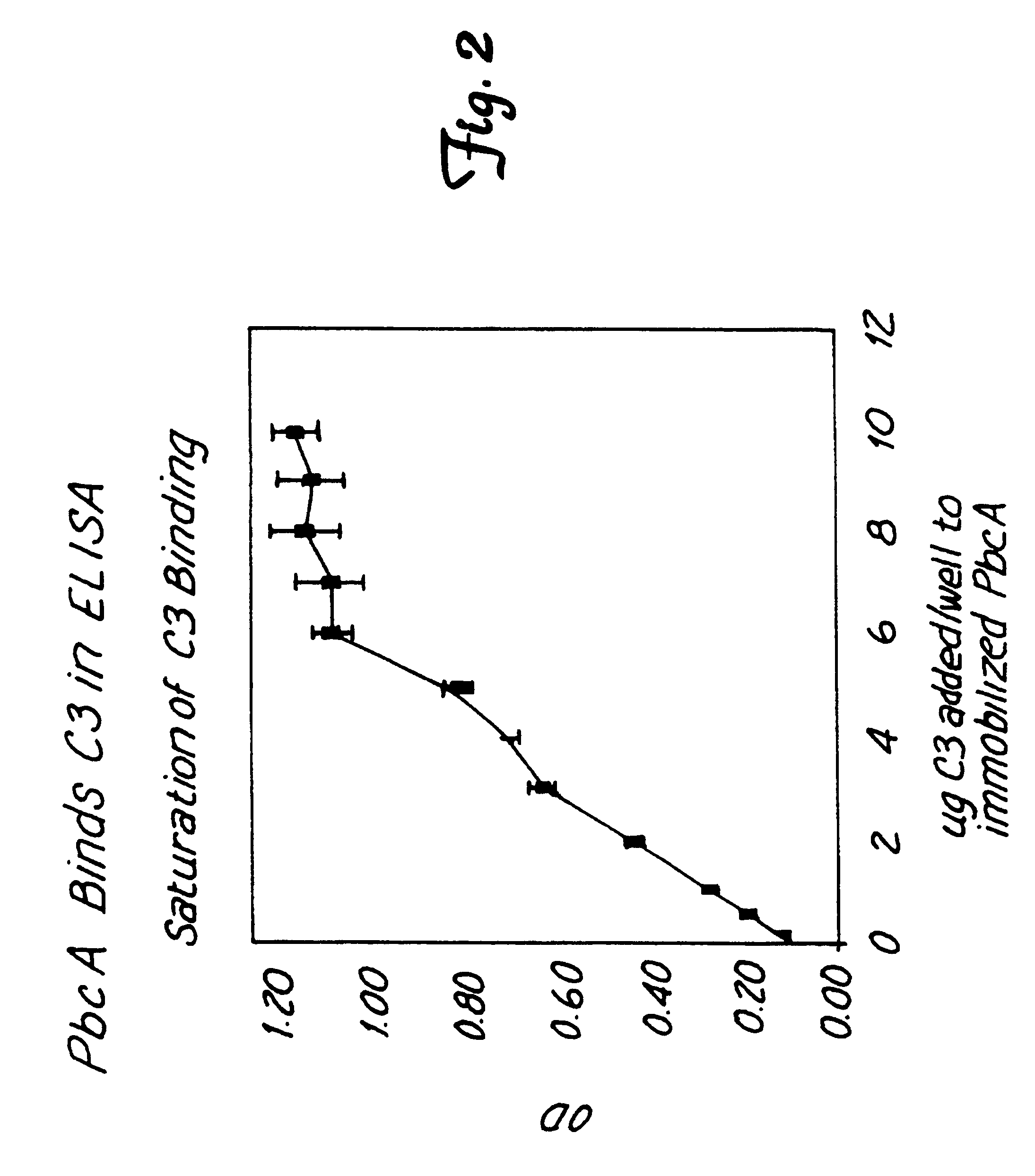Method for isolating a C3 binding protein of streptococcus pneumoniae
a technology of streptococcus pneumoniae and binding protein, which is applied in the direction of peptide/protein ingredients, antibody medical ingredients, peptide sources, etc., can solve the problems of prohibitive financial and technical complications, and individuals who demonstrate the greatest risk of severe infection are not able to make antibodies to the current capsular polysaccharide vaccine,
- Summary
- Abstract
- Description
- Claims
- Application Information
AI Technical Summary
Problems solved by technology
Method used
Image
Examples
example 1
Identification of PbcA from S. pneumoniae
10 ml of S. pneumoniae strain CP1200 (obtained from D. A. Morrison. University of Illinois, Champagne-Urbana, Ill. and described in Havarstein L. F., et al. Proc. Natl. Acad. Sci. (USA) 1995;92:1 1140-11144) was grown to exponential phase (O.D..sub.620 =0.3) in Todd Hewitt broth (Fisher, Pittsburgh, Pa.) or in a synthetic medium (O.D..sub.620 =0.15, media described by Sicard, A. M. Genetics 1964 59:31-44). Pneumococcal cells were pelleted and the supernatant was removed and precipitated with a final concentration of 10% trichloroacetic acid (TCA) at 4.degree. C. overnight and samples were electrophoresed on 15% sodium dodecyl sulfate polyacrylamnide gels (SDS-PAGE) under non-reducing conditions. Pneumococcal proteins separated by electrophoresis were then transferred to nitrocellulose for Western blotting. After blocking of the Western blot according to standard protocols (Harlow, et al. Antibodies; A Laboratory manual. Cold Spring Harbor, N....
example 2
Purification of PbcA
S. pneumoniae CP1200 was grown to mid-exponential phase in 4 liters of Todd Hewitt broth at 37.degree. C. Pneumococcal cells were pelleted by centrifugation at 10,000.times.g for 10 minutes. Proteins in the supematant were precipitated with a final concentration of 10% trichloroacetic acid at 4.degree. C. overnight. The precipitate was resuspended in 40 mls of 100 mM Tris and the final pH adjusted to 7.0. The resuspended proteins were chromatographed on a 1.2 ml column of Thiopropyl Separaose 6B coupled by a disulfide bond to 4 mg methylamine treated human C3. The column was then washed with 40 ml of 100 mM Tris-HCl, pH 7.0 containing 0.5 M NaCl. PbcA was eluted from the column with 20% ethanol in the Tris-HCl / NaCl wash buffer. 1 ml. fractions were collected and analyzed by SDS-PAGE and C3 binding assay. A protein of about 90 kDa to about 110 kDa (+ / -5 kDa) eluted from the C3 affinity column in fractions 2-10.
Multiple eluates from sequential purifications of PbcA...
example 3
Immunogenicity of PbcA
Immunogenicity of PbcA was assessed by growing 10 ml of S. pneumoniae strain CP1200 to exponential phase in Todd Hewitt broth, pelleting the cells, and precipitating proteins from the supernatant with 10% TCA overnight at 4.degree. C. The next day, supernatant proteins were electrophoresed on 15% SDS-PAGE, transferred to nitrocellulose, blocked with skim milk in a standard protocol (Harlow, et al. supra) and incubated with a 1:10,000 dilution of acute or convalescent serum from a patient infected with S. pneumoniae (Dr. E. Janoff, Minneapolis Va. Hospital, Minneapolis, Minn.). The blot was washed according to methods disclosed in Harlow et al. and incubated with a 1:50,000 dilution of commercially purchased goat anti-human IgG conjugated to horseradish peroxidase (Chemicon, Temicula, Calif.). The blot was-washed and developed with the Supersignal.TM. system according to manufacturer's instructions.
Western blots from these studies demonstrated that acute serum d...
PUM
| Property | Measurement | Unit |
|---|---|---|
| temperature | aaaaa | aaaaa |
| molecular weight | aaaaa | aaaaa |
| mass | aaaaa | aaaaa |
Abstract
Description
Claims
Application Information
 Login to View More
Login to View More - R&D
- Intellectual Property
- Life Sciences
- Materials
- Tech Scout
- Unparalleled Data Quality
- Higher Quality Content
- 60% Fewer Hallucinations
Browse by: Latest US Patents, China's latest patents, Technical Efficacy Thesaurus, Application Domain, Technology Topic, Popular Technical Reports.
© 2025 PatSnap. All rights reserved.Legal|Privacy policy|Modern Slavery Act Transparency Statement|Sitemap|About US| Contact US: help@patsnap.com


